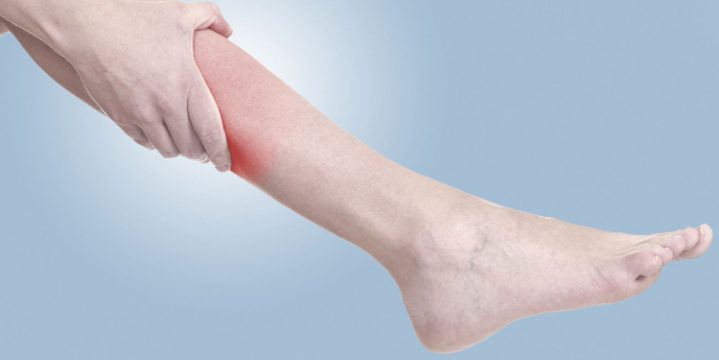Muscle Cramping And You: A Technical Look

Cramping up is a bummer dude. It’s a common issue in the sports world, but there are a lot of people that don’t understand the mechanics of their muscles and don’t know what this painfully obvious warning sign means and how to alleviate it. As Mr. Miyagi said “To overcome an obstacle, you must first understand what the obstacle is.” Well, I think he said that. Sounds like something he’d say at least. Anyway, let’s get physical!
The Mayo Clinic defines muscle cramps as “a sudden and involuntary contraction of one or more of your muscles” and caused by “overuse of a muscle, dehydration, muscle strain or simply holding a position for a prolonged period of time may result in a muscle cramp. In many cases, however, the exact cause of a muscle cramp isn’t known.” And that is what makes muscle cramps so tricky, is that its a symptom of several complicated issues. But you can usually put the cramp into 3 possible categories. These are: inadequate blood supply to the affected area, nerve compression in the spine, and/or mineral depletion (specifically the minerals potassium, calcium, magnesium, and sodium.) I’d like to take a look at the role diet plays in nourishing and activating muscle fibers.
Magnesium, the body’s chemical middle-manager.
Magnesium affects more than 300 enzyme-based biochemical reactions inside of your body. It’s the second most abundant mineral in your cells. Good thing it’s found pretty much everywhere, since it’s the central element in chlorophyll (more like bore-ophyll). To understand how magnesium relates to muscle contractions, you have to understand the process of converting ATP (adenosine tri-phosphate) to energy. ATP is made by your cell’s mitochondria, think of it as gasoline for your engine. And in order to get this molecule out of your cells and into the rest of your body, it needs to bind with magnesium. Once magnesium is bound to ATP, it can finally pass through the cellular barriers, providing energy to the rest of your body. Multiply that process billions of times, and you get enough energy to power your brain and muscles. In addition to synthesizing proteins, create and protect DNA and RNA, and regulate cholesterol production. So eat your veggies, and an occasional sensory deprivation float wouldn’t hurt.
Potassium if you’re active.. Radioactive…
Yes, potassium is a radioactive isotope, found naturally. No worries though, homeostasis ensures that the body never accumulates too much potassium. Potassium and sodium work together in what’s called the “sodium-potassium pump”. Here’s a video to help visualize this process. But to sum it up, the transfer of the sodium ions with the potassium ions is what allows a signal to move down the nerve cells to it’s target cell, causing (amongst many other things) muscle contractions. It’s important to note that the body does store sodium, but it doesn’t store potassium. Our diets should be rich in fruit and nuts to make sure the body gets enough potassium. Our bodies used to have to conserve sodium since we didn’t eat it very often. Unfortunately our biochemical processes haven’t caught up with the McDonald’s value menu.
Calcium. The Rick Moranis to muscle fiber’s Sigourney Weaver.
The last stop here is calcium. 99% of the calcium in our body is stored in our bones and teeth. But that’s not it’s only purpose, that last 1% plays an enormously important role in muscle contraction. So important that our body will take calcium from your bones (Hello, osteoporosis!) when your body is running low. Calcium is the actual element that causes a muscle to contract. If you have 10 minutes, check this video which explains how calcium triggers muscle tissue. Essentially the calcium ions ‘unlock’ the tropomyosin gate which allows the myofibril to crawl along the actin molecule, contracting the space between the actin strands. This shows this crawling taking place. Without calcium, you would have no muscle contractions at all, including your heart.
When your sodium, potassium, magnesium and calcium levels are off, it wreaks havoc on your muscles. Magnesium frees the energy your body needs. Potassium and sodium move the energy signal down to your muscles, where calcium activates the actual muscle contraction and release. So when you start cramping, know that it’s a long and complicated chain of events that lead you to this moment. A good place to start thinking about your diet is at your doctor’s office. They can do a vitamin and mineral test to see what needs to be tuned. Proper fitness starts with a proper diet and hydration.
Resources:
http://www.mayoclinic.org/diseases-conditions/muscle-cramp/basics/causes/con-20014594
http://en.wikipedia.org/wiki/Arteriosclerosis
http://www.ancient-minerals.com/magnesium-benefits/what-is-function/#energy
http://www.newcastle-mitochondria.com/mitochondria/what-do-mitochondria-do/
http://en.wikipedia.org/wiki/Amino_acid_activation
http://www.health.harvard.edu/newsweek/Understanding_Cholesterol.htm
http://www.mg12.info/articles/cramps.html
http://en.wikipedia.org/wiki/Electrolyte
http://www.merckmanuals.com/home/brain_spinal_cord_and_nerve_disorders/symptoms_and_diagnosis_of_brain_spinal_cord_and_nerve_disorders/muscle_cramps.html
http://www.livestrong.com/article/537907-how-can-low-calcium-levels-affect-the-release-of-neurotransmitters/


